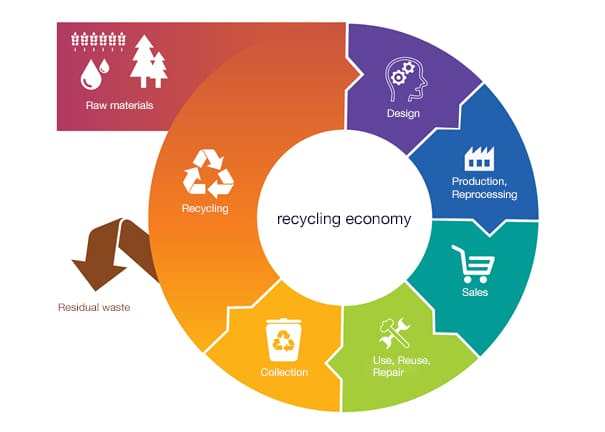Cradle to Cradle: not only optimizing the CO² footprint through recycling management but also creating value retention
The fact that resources are becoming increasingly scarce and material is not infinitely available is neither a secret nor a revelation. The changeover to sustainable materials and renewable resources is therefore logical and sensible. However, this is often associated with significant restrictions in design and function or even technically impossible. The UN warns that the annual global consumption of resources will double by 2060 and that greenhouse gas emissions will continue to rise dramatically. At the same time, the World Bank estimates that global annual municipal waste will have increased by 70 percent by 2050.
Five years ago, the EU Commission published the „EU Action Plan for the Circular Economy“, which aims to promote the transition to a more circular economy in the EU. The fact that Europe is only at the beginning of a long-term process is illustrated by the following figure: in 2016, on average only 12 percent of the material resources used in the EU came from recycled products and recovered materials. But have we picked up speed here in the last five years?
What can be discovered on the market is the will to come up with great ideas and solutions, both in process engineering for the production and use of recycled material, but also in processing, material separation and recovery. However, more steps are needed to close the loop. And last but not least it depends on the acceptors of the customers to remove the dogma: „New is always better“ and thus force companies and producers to rethink. But there are still some challenges to be mastered, which will be examined in the following.
How durable and recyclable are products?
Regarding the waste management side of the circular economy – recycling – Germany is one of the pioneers in the EU. In terms of waste avoidance, long product service life, recycling friendly product design and material efficiency, it is clear that Germany, like Europe as a whole, still has great potential for development.
An interesting aspect is certainly also the spatial discrepancy between the place of original production and thus the possible place of reuse of the material in order to ensure a close cycle, and on the other hand the place of use and the presumed nearby place of collection. Is the recycling process also there to close this spatial distance.
One should not forget the difficult separability of materials. Since the design and development in the last decade was driven more and more to composite materials and components under cost aspects, it is very difficult to separate these materials in the recycling process and to use them further. This has to be rethought in the design process and a recyclability and also the use of already recycled material should be included in every briefing. A loss of function and performance should be avoided if possible.
With the example of household electronics, the voices are getting louder and louder that the devices are only fixed for a certain lifetime from the beginning and should be thrown away afterwards to trigger a new purchase. Nevertheless, the aim is to generate such a high level of customer satisfaction that customers remain loyal to the brand and sales channel in every case. When there was even less complexity in the devices, reuse and repair were normal topics and were partly still implemented in the classic tinkering cellar. The reparability of appliances is also prevented here, as is the separability of materials, by cost pressure and optimized design. Sometimes a repair is not economically feasible, because trying to repair would cause more damage in order to get to the parts to be repaired. In the worst case, the fault would additionally appear in a component that can only be replaced as a whole.
How is the CO² Footprint calculated?
If we solve these issues in future generations of products now, the question of measurability and success representation still arises. On the one hand one can surely measure the reduced CO² quantity, which results with same period of observation, by dressing and recycling in relation to the completely new creation. However, the value is today the CO ² from political initiative probably unfortunately not sufficiently gets around the possible additional costs for repairable and recyclable Design to adjust. Meaningful one loosens oneself from the classical bookkeeping viewpoint that an investment is written off after a certain duration of the use and thus has only an obligatory value, but rather attaches a value to the materials used in the investment, which also corresponds to the raw materials becoming scarcer. So instead of destroying value by simply throwing products into the waste, value is maintained.
In view of the current situation and the upcoming challenges, only the question of motivation remains to be answered. There are complex answers depending on the perspective but also the values and culture of a company. The simplest view is the pressure of the market. In the area of consumer goods, the pressure from consumers for waste avoidance, climate neutrality and „sustainable“ products is becoming ever greater. The paradox here, however, is that the customer above all does not want to radically change his habits and behavior. This ranges from the increased number of meat replacement products to coffee capsules. In a somewhat more complex view, a company that thinks long-term cannot ignore the possible effects of a shortage of raw materials. When this will occur for your own product area may be individual, but the war for raw materials will not be prevented with an increasing number of the world population, if you do not think about possible alternative sources and try to close the cycle.
The challenges of closing the circle and the dependency of possible collection possibilities have already been considered in a previous block article and shall only be mentioned here.
To sum it up:
The change to a Circular Economy will not happen by itself, but it is definitely necessary to avoid the shortage of raw materials in the long run. The main obstacles are higher costs of high-quality recycling and processing compared to other waste disposal options such as waste incineration or downcycling, low prices for primary raw materials and a so far too low demand for recycling products
For successful implementation, it is also important that all players in the value-added cycle assume responsibility and cooperate with each other – from product designers and producers to retailers and consumers to companies in the recycling industry.
This is where today’s corporate leaders should take a far-sighted approach and set the course today for possible business fields of the future and critically review their current portfolio. Adconia has assisted some of its clients in analyzing the possibilities and assessing the possible path into the future, also using methods such as Regnose. If you have identified this topic for your company, please contact us.

Author
Rainer den Ouden

